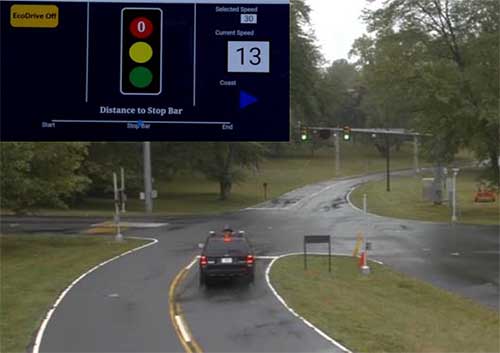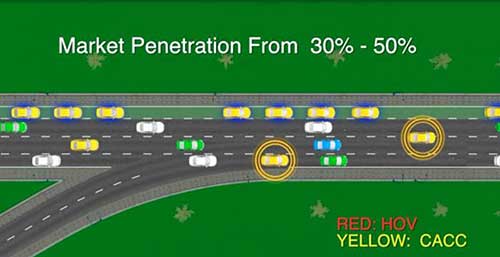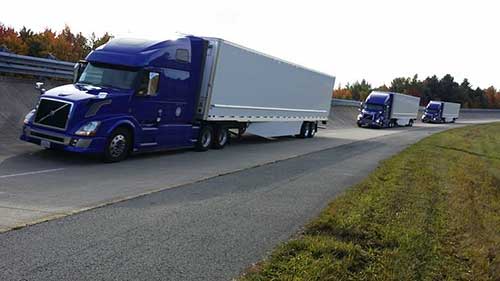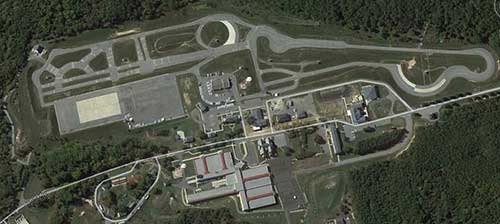U.S. Department of Transportation
Federal Highway Administration
1200 New Jersey Avenue, SE
Washington, DC 20590
202-366-4000
Federal Highway Administration Research and Technology
Coordinating, Developing, and Delivering Highway Transportation Innovations
| FACT SHEET |
| This fact sheet is an archived publication and may contain dated technical, contact, and link information |
| Publication Number: FHWA-HRT-17-031 Date: January 2017 |
Publication Number: FHWA-HRT-17-031 Date: January 2017 |
PDF Version (814 KB)
PDF files can be viewed with the Acrobat® Reader®
The Federal Highway Administration’s (FHWA) Saxton Transportation Operations Laboratory (Saxton Laboratory) was established in 2011 and is located at the Turner-Fairbank Highway Research Center in McLean, VA. The state-of-the-art facility provides the Office of Operations Research and Development (R&D) cutting edge technologies and tools for conducting futuristic transportation operations research.
The Saxton Laboratory is supplementing the Office of Operations R&D’s connected automation research program, which includes an initial focus on applications that use longitudinal control, with active driver engagement and advisory information, to improve transportation operations. The Saxton Laboratory develops, assesses, and tests advanced concepts using experimental vehicles at test tracks and, in some cases, on operating roadways. Recent projects include cooperative adaptive cruise control (CACC), speed harmonization, cooperative lane change and merge, as well as Eco-Approach and departure from signalized intersections. Further research is needed to understand how lateral control could enable cooperative lane changes and merging, achieve better lane balancing in congested traffic, and allow significantly narrower lanes and other geometric changes to increase efficiencies in building and operating roadways.
 Source: FHWA |
| CACC demonstration using Saxton Laboratory connected vehicles |
FHWA’s timeline for the connected automation research program anticipates public roadway testing of passenger vehicles and trucks with longitudinal control capabilities by 2023. The connected automation research program will enable partnerships with automotive manufacturers as well as infrastructure owners and operators to develop and deploy automation applications that can provide significant mobility, safety, and environmental performance benefits to the public.
 Source: FHWA |
| Partially-automated driving in a test of the GlidePath application at the Saxton Laboratory provided a 22-percent fuel savings benefit. |
 Source: FHWA |
| Screenshot of an FHWA simulation showing improvements in traffic flow through increases in market penetration of CACC technology. |
Emerging transportation applications—especially connected and automated vehicle (CAV) technologies—offer potentially transformative societal impacts, including significant mobility, safety, energy, and environmental benefits. Current traffic analysis and planning tools are not well suited for evaluating CAV and other emerging applications, because they are unable to incorporate vehicle connectivity, communications, and automated features. Guidance on how these analysis tools can be extended to evaluate CAV applications is nonexistent and CAVs are being introduced into a complex transportation system where impacts, such as demand changes, modal shifts, and rerouting, must be quantified.
Research at the Saxton Laboratory will estimate and evaluate emerging applications; develop enhanced analysis, modeling, and simulation (AMS) tools for researchers and practitioners; collaborate with industry to push these AMS capabilities into commercial software; and provide deployment guidance. The AMS tools will help estimate mobility, safety, energy, and environmental benefits as well as increase the likelihood that CAV technologies will be deployed properly and bring the expected benefits to the Nation’s transportation system.
The Office of Operations R&D, in conjunction with the Office of Freight Management and Operations, the FHWA Resource Center, and the Intelligent Transportation Systems Joint Program Office, aim to conduct research to improve the efficiency, safety, and security of the Nation’s intermodal freight transportation system. The Saxton Laboratory will support research efforts as they relate to topics such as:
 Source: FHWA |
| FHWA truck platooning study in partnership with the Canadian government. |
While the Saxton Laboratory’s testbed offers an environment for proof-of-concept, low-speed testing, additional closed testing environments, from entities such as the Department of Homeland Security (DHS) and the U.S. Army, greatly enhance research capabilities. These collaborative testing environments serve as proving grounds for more advanced levels of testing and system validation of technology concepts at higher speeds before they are readied for field trials in real-world conditions. The Saxton Laboratory maintains working relationships with the DHS’ Federal Law Enforcement Training Center (FLETC) in Cheltenham, MD, as well as with the U.S. Army’s Aberdeen Proving Ground in Aberdeen, MD.
 Source: DHS |
| DHS partnership provides extended closed-track testing at FLETC |
The Office of Operations R&D aggressively engages in transportation operations research to explore new technologies and practices that have the potential to improve transportation operations and system performance. Research will emphasize development of next generation transportation operations and management technologies and strategies enabled by connected vehicles, advanced infrastructure, active transportation management and decision support systems, wireless communications, GPS and digital mapping, robotics, and the exploration of augmented and virtual reality capabilities.
Additional emphasis is on exploiting new enabling technologies to build smarter, more connected and integrated services and systems such as ad hoc mobile networks, cyber physical systems, new data sources and analytical techniques, and integrated operational data environments. Early collaboration with industry will expedite the research cycle, bringing implementation of next generation technologies and strategies sooner. Information on the Office of Operations R&D is available at: www.fhwa.dot.gov/research/tfhrc/offices/operations.